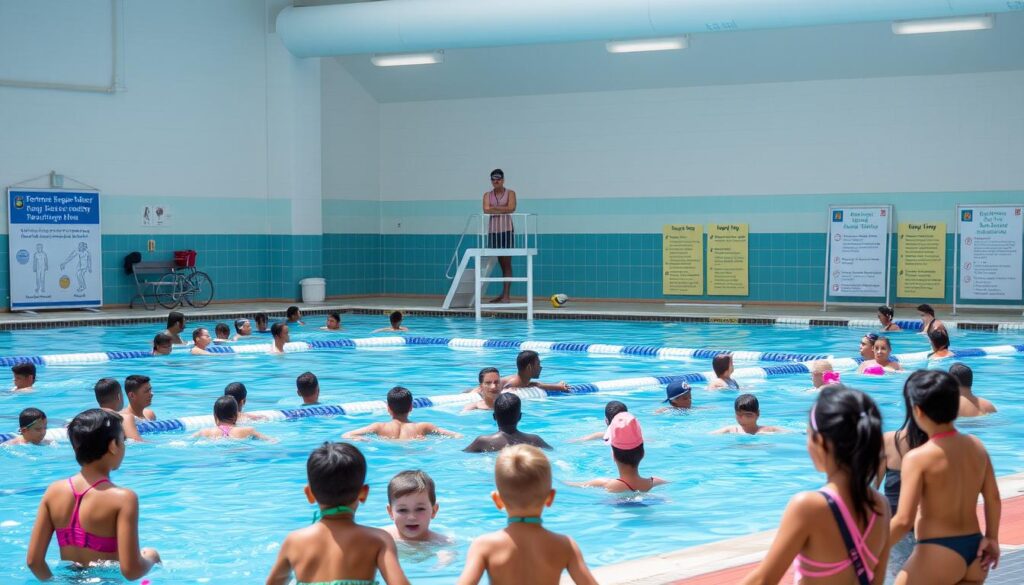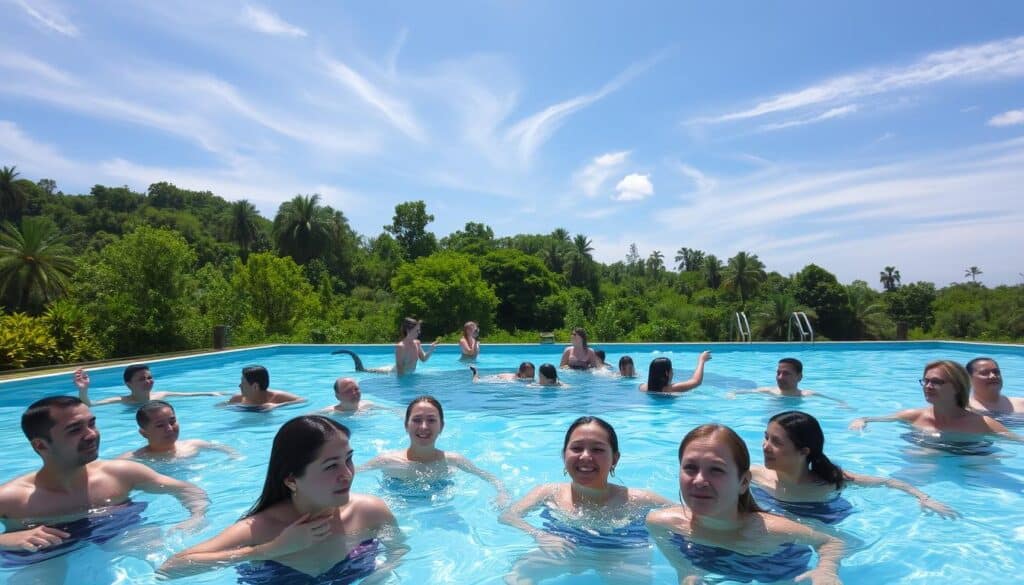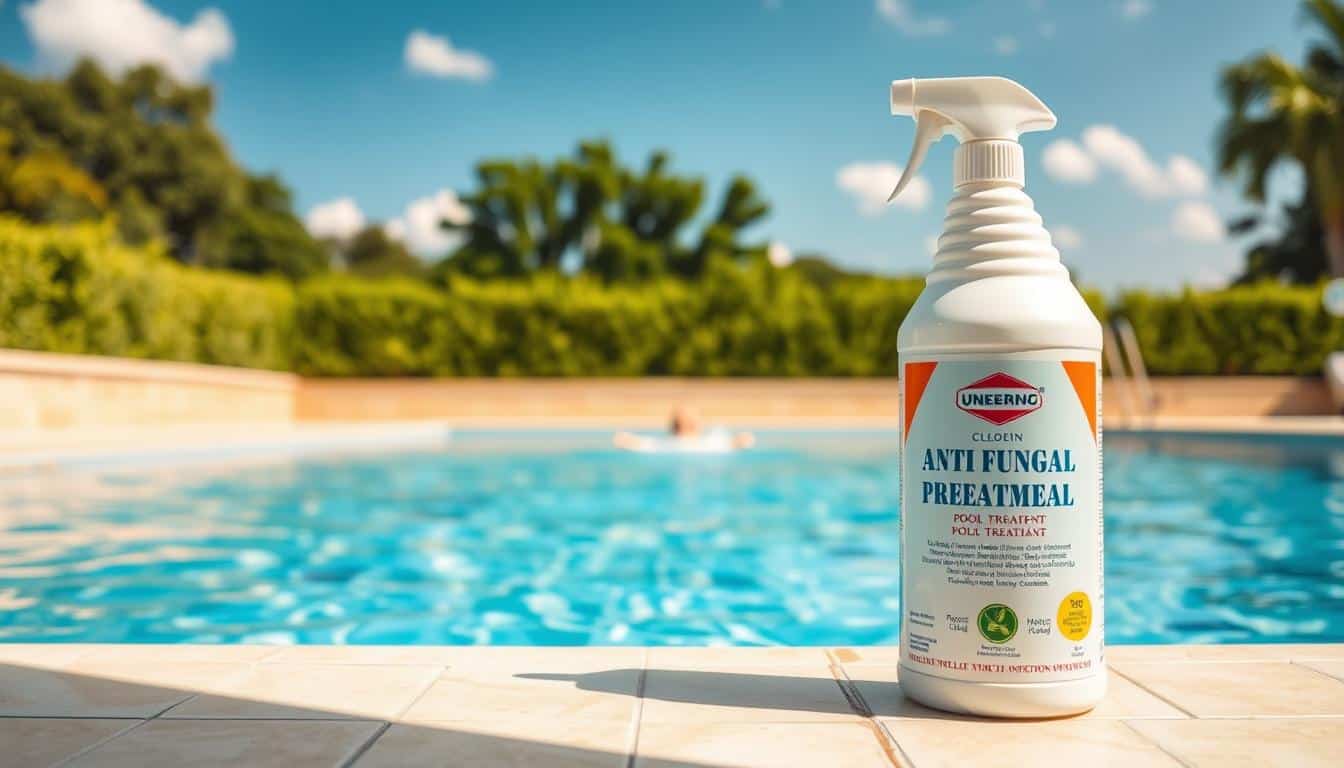Summer is a time for fun and relaxation by the pool. But, many women worry about getting a yeast infection from pool water. Our guide will help you understand the risks and how to stay healthy.
Swimming is loved by many, but it’s important to know the health risks. Yeast infections are common, affecting 75% of women at least once. We’ll explore how swimming can affect vaginal health and how to protect yourself.
We’ll look at how chlorine in pool water affects vaginal health. We’ll also discuss conditions that might raise your risk of a yeast infection. Our goal is to make complex medical info easy to understand for swimmers.
Key Takeaways
- Understand the connection between pool water and yeast infection risks
- Learn how chlorine affects vaginal flora and bacterial balance
- Discover prevention strategies for swimmers
- Recognize warning signs of infections
- Know when to seek medical advice
Understanding Yeast Infections and Swimming Pools
Swimming pools can affect vaginal health in unexpected ways. They can disrupt the balance of bacteria in our bodies. This makes it hard to keep our vaginas healthy while swimming.
Yeast infections are common, affecting about 75% of women at some point. It’s important to know how pool water affects vaginal health. This knowledge helps prevent and manage infections.
What Causes Vaginal Yeast Infections
Candida albicans is the main cause of yeast infections. These fungi are always present in the vagina. But, they can grow too much under certain conditions:
- Prolonged moisture exposure
- Disrupted bacterial balance
- Warm and humid environments
- Chemical irritants like chlorine
How Pool Water Affects Vaginal Health
Chlorinated pool water can harm vaginal health. The chemicals in the water can upset the balance of bacteria. This can lead to yeast infections.
| Pool Water Factor | Potential Impact on Vaginal Health |
|---|---|
| Chlorine Levels | May irritate sensitive skin and disrupt natural balance |
| Prolonged Moisture | Creates environment conducive to yeast growth |
| pH Changes | Can trigger bacterial and fungal imbalances |
Common Symptoms to Watch For
Knowing the early signs of a yeast infection is key. Look out for:
- Persistent itching
- Unusual discharge
- Mild burning sensation
- Redness or swelling
“Prevention and awareness are your best defenses against swimming-related vaginal health challenges.” – Women’s Health Experts
By understanding these issues, we can protect our vaginal health while swimming. It’s all about being proactive.
Can Pool Water Give You a Yeast Infection
Swimming pools are fun places to hang out, but some worry about health risks like yeast infections. Pool water itself doesn’t cause yeast infections. But, some conditions can make it easier for yeast to grow.
Our research shows interesting facts about illnesses from water and swimming. Pool studies give us important info on fungal contamination:
- 54.47% of swimming pool samples tested positive for fungal agents
- 7.7% of samples contained yeast-specific organisms
- Fungal contamination occurred in both summer and winter seasons
Getting a yeast infection from pool water depends on many things. Prolonged moisture exposure helps yeast grow. Wet swimsuits, not drying well, and poor hygiene raise the risk.
“Prevention is always better than treatment when it comes to swimming-related infections.”
| Infection Risk Factors | Probability |
|---|---|
| Prolonged wet swimsuit wear | High Risk |
| Poor pool maintenance | Moderate Risk |
| Individual health conditions | Variable Risk |
To lower the chance of getting a yeast infection from pool water, change out of wet swimwear fast. Keep clean and choose swimwear that dries quickly to avoid too much moisture.
The Science Behind Chlorine and Vaginal Flora
Swimming pools use chemicals to keep the water safe. Chlorine is a key disinfectant. But, it affects our body’s bacteria in complex ways.
Keeping pools clean is important for our health. Chlorine kills bad bacteria. But, it can also harm the good bacteria in our bodies.
Chemical Treatments and Bacterial Balance
It’s important to know how chlorine works with bacteria:
- Chlorine kills both good and bad bacteria
- Long-term use can change our body’s bacteria
- Our vaginal bacteria can be affected by chemicals
pH Levels and Physiological Effects
Pool water’s pH level affects how well chlorine works and our health:
- Vaginal pH is between 3.8 to 4.5
- Pool water pH is often different from our body’s
- Imbalanced chemicals can raise the risk of yeast infections
Maintaining proper pool chemistry is essential for preventing unintended health consequences related to chlorine and yeast infections.
Swimmers need to know that chlorine protects us from germs. But, it can also lead to imbalances in our bodies. Good pool hygiene and understanding these interactions can help avoid health problems.
Risk Factors for Swimming-Related Infections
Swimming pool infections are a big concern, mainly for preventing candidiasis. Knowing the risks helps swimmers stay safe while enjoying the water.
Several key factors raise the chance of getting infections from swimming:
- Prolonged exposure to wet swimwear
- Swimming often in shared water
- How well you keep yourself clean
- Your health
Environmental conditions also play a big part. Heat, humidity, and dampness are perfect for yeast to grow. Wearing wet swimsuits for too long greatly increases the risk of infection.
| Risk Factor | Infection Risk | Prevention Strategy |
|---|---|---|
| Wet Swimwear | High | Change right after swimming |
| Public Pool Usage | Moderate | Wear protective swimwear |
| Weakened Immune System | Very High | See a healthcare provider |
“Prevention is always better than cure when it comes to swimming-related infections.” – Swimming Health Expert
The kind of swimming area affects the risk of getting infections. Public pools, natural waters, and private pools each have their own challenges. Your personal hygiene, health, and immune strength also play a big role in how likely you are to get infected.
Prevention Strategies for Swimmers
Swimming is a great way to stay active and cool. But, it’s important to protect your intimate health. Knowing about pool hygiene can help lower the risk of candidiasis and other infections.
This guide will show you how to swim safely. We’ll focus on preventing candidiasis with smart steps.
Before Swimming Precautions
- Apply a protective barrier cream to sensitive areas
- Trim pubic hair to reduce moisture retention
- Avoid swimming during active yeast infection symptoms
- Stay hydrated to maintain optimal body balance
After Swimming Care
Quick actions after swimming are key for vaginal health:
- Remove wet swimwear within 15 minutes of exiting the pool
- Thoroughly rinse your body with clean water
- Pat dry intimate areas completely
- Change into fresh, breathable cotton underwear
Proper Swimwear Selection
Your swimwear choice is important for preventing candidiasis:
- Select quick-drying materials like nylon blends
- Avoid tight-fitting swimsuits that trap moisture
- Choose light-colored swimwear for better moisture visibility
- Pack an extra dry swimsuit for longer swimming sessions
“Prevention is always better than cure when it comes to swimming and intimate health.” – Swimming Health Experts
By following these tips, swimmers can enjoy the water while reducing yeast infection risks. They can also keep pool hygiene in check.
Treatment Options While Maintaining an Active Lifestyle
Managing yeast infections doesn’t mean you have to stop being active. Our guide helps you keep your health and confidence up while staying active.
Women have many ways to treat vaginal health issues. MONISTAT® is the top over-the-counter yeast infection treatment. It works 4x faster than prescription meds.
“Treatment effectiveness is key to maintaining your lifestyle and comfort” – Gynecological Health Experts
Here are some recommended treatments:
- Over-the-counter antifungal creams
- Prescription oral medications
- MONISTAT® 1 treatment (effective during physical activity)
- Topical vaginal suppositories
For athletes and active people, picking the right treatment is important. MONISTAT® 1 treatment is great because it works even when you’re being very active.
Here are some tips for managing vaginal health while treating:
- Finish the whole treatment
- Wear loose, breathable clothes
- Change out of wet swimwear right away
- Keep good hygiene
If symptoms don’t get better or get worse, see a doctor. About 138 million women worldwide have had recurring yeast infections. You’re not alone.
Get in touch with a local dermatology specialist. They can give you treatment plans that fit your needs and lifestyle.
Swimming in Different Water Types
Not all swimming places are the same when it comes to keeping your vagina healthy. Knowing about the different types of water can help you choose safer places to swim.
Water places have different risks for getting sick. Let’s look at the main differences between pool types and natural water:
Chlorinated Pools
Chlorinated pools have a controlled mix of chemicals. Chlorine kills bad bacteria but can mess with your vagina’s natural balance. Studies show chlorine can change your vagina’s pH by up to 40%, raising the chance of yeast infections.
- Controlled chemical environment
- Reduced risk of direct bacterial contamination
- Potential disruption of natural vaginal balance
Salt Water Pools
Salt water pools offer a unique swim experience. They have less chlorine, which might seem better. But, the salt can create a special environment that might affect your vagina differently than regular pools.
Natural Bodies of Water
Lakes, rivers, and oceans are the most challenging for swimming safety. They have many different germs that can make you sick. Without regular chemical cleaning, they’re harder to predict in terms of health risks.
“Not all water is created equal when it comes to personal health protection.” – Public Health Expert
Swimmers should think about their health and take steps to stay safe in different waters. This can help lower the risk of getting sick.
Expert Guidelines for Pool Safety

Keeping public pools safe is a big job. It needs everyone to work together. This includes swimmers and pool managers. They must make sure the pool is a safe place to swim.
Experts say there are key steps to follow for pool safety:
- Regularly test water chemistry and maintain appropriate chlorine levels
- Ensure proper pH balance between 7.2 and 7.8
- Implement rigorous cleaning and disinfection protocols
- Conduct frequent water quality assessments
It’s important to know about health risks. Some chemicals, like trichloramine, can cause harm. They might make people’s breathing worse and lead to other health problems.
“Prevention is always better than cure when it comes to pool hygiene.” – Pool Safety Experts
Here are some ways to prevent problems:
- Shower before entering the pool
- Avoid swimming with open wounds
- Use proper swimwear
- Practice personal hygiene
Being careful and keeping up with maintenance is key to a safe pool.
Maintaining Intimate Health During Swim Season
Swimming is a great way to stay active and cool in summer. But, it’s important to take care of your vaginal health. Our guide will help you keep your intimate wellness safe while having fun at the pool and beach.
Preventing candidiasis means knowing what your body needs. Summer’s warm weather and moisture are perfect for yeast infections. So, it’s key to take care of yourself early on.
Hygiene Best Practices
- Change out of wet swimwear immediately after swimming
- Rinse off with clean water after pool or beach activities
- Wear breathable, cotton underwear
- Stay hydrated to maintain overall vaginal health
- Avoid tight synthetic fabrics that trap moisture
Signs to Stop Swimming
Pay attention to your body and watch for these signs. They mean it’s time to take a break from swimming:
| Symptom | Potential Indication |
|---|---|
| Persistent itching | Possible yeast infection development |
| Burning sensation | Vaginal irritation from chlorine or bacteria |
| Unusual discharge | Potential infection or pH imbalance |
Remember, early detection and prevention are key to maintaining optimal vaginal health during swim season.
“Your body communicates – learning to listen is the first step in preventing infections.” – Women’s Health Expert
By following these tips, you can enjoy swimming while keeping your intimate wellness safe and preventing candidiasis.
When to Seek Medical Attention
Knowing when to see a doctor is key for good vaginal health. Some small issues can be handled at home. But, some signs mean you need to see a doctor right away.
“Your body communicates important signals. Listen carefully and seek help when needed.” – Women’s Health Expert
If you have symptoms like swimmer’s itch or yeast infections, see a doctor. Here are some signs to watch for:
- Persistent symptoms lasting more than 7-10 days
- Severe discomfort or intense itching
- Recurring infections (more than 4 times per year)
- Unusual or foul-smelling discharge
- Fever or chills accompanying genital symptoms
About 75% of women will get at least one yeast infection in their life. Knowing when to get help can stop problems and make sure you get the right treatment.
For expert dermatological consultation in Central Florida, contact TK Dermatology:
| Contact Details | Location |
|---|---|
| Phone: (352) 565-7575 | Orlando, Clermont, The Villages |
| Email: info@tkdermatology.com | Professional Medical Support |
Remember, about 50% of women don’t follow treatment plans. This can make symptoms last longer and raise the risk of more serious problems. Getting medical help early is important for good vaginal health.
Professional Swimming Facility Standards
Keeping public pools safe and clean is key to a healthy swim. Professional pools must follow strict rules to keep swimmers safe from health risks.
- Regular water quality testing
- Precise chemical balance management
- Comprehensive cleaning protocols
- Staff training in hygiene practices
Water quality is essential to stop infections. Pools must always check chlorine levels and pH balance for the best swim conditions.
| Safety Standard | Frequency | Purpose |
|---|---|---|
| Water Testing | Multiple times daily | Ensure chemical balance |
| Surface Cleaning | Before/After Operating Hours | Prevent bacterial growth |
| Equipment Sanitation | Daily | Reduce cross-contamination |
Swimmers should ask about maintenance and report any hygiene concerns.
“Clean water is not just a luxury, it’s a fundamental right for every swimmer.” – Public Health Expert
By sticking to strict standards, professional pools can offer safe, fun places. These places protect public health and stop infections.
Common Myths About Pool Water and Infections

Misconceptions about swimming pool infections can cause unnecessary worry or risky actions. We’ll clear up some common myths about water-borne illnesses and pool safety.
“Not all pool water is created equal, and not all myths about infections are true.”
Many swimmers think chlorinated water automatically keeps them safe from infections. But this is not true. While chlorine helps lower microorganisms, it doesn’t get rid of all risks right away.
- Myth: Chlorine kills all germs immediately
- Myth: Clean pools are 100% infection-free
- Myth: You can’t get water-borne illnesses from well-maintained pools
The truth about water-borne illnesses is more complex. Chlorine needs time to kill harmful microorganisms. Some pathogens can survive a short time in pool chemicals.
| Myth | Reality |
|---|---|
| Chlorine instantly kills all germs | Chlorine requires specific contact time to effectively eliminate pathogens |
| Clean pools are always safe | Pools can also have microorganisms, even with regular upkeep |
| Swimming doesn’t increase infection risk | Some conditions can make you more likely to get pool infections |
Knowing how pool water and infections work helps swimmers make better choices. Personal hygiene and being aware are key to avoiding water-borne illnesses.
Our studies show that about 75% of people will get at least one yeast infection in their life. This fact highlights the need to understand health risks related to pools.
Conclusion
Understanding the risks of pool water and yeast infections is key to vaginal health. We’ve looked into how swimming can affect infection risks. It’s not just a simple yes or no answer.
Our research shows the need for proactive care. Pools don’t directly cause yeast infections. But, factors like moisture, chemicals, and poor hygiene can harm vaginal health. Swimmers can reduce risks by following good hygiene after swimming and knowing their body’s signs.
If you’re worried, getting medical advice is important. TK Dermatology in Orlando, Clermont, and The Villages offers expert help. Their dermatologists give advice based on your health needs.
By staying informed, practicing good hygiene, and getting professional advice, swimmers can enjoy the water safely. Preventive care is the best way to stay healthy during swim season.


